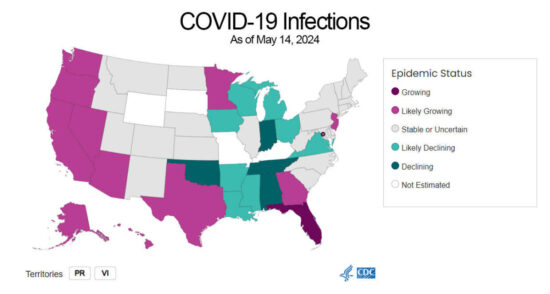Getting kids off vapes, estrogen therapy is safe after all, the military might make its own drugs, and more
21 May 2024
Posted by Andrew Kantor
Reversal of fortune, hormone therapy edition
About 20 years ago, women were told that hormone therapy could increase their cancer risk. But it turns out the people who released that info were bureaucrats, not the scientists doing the study. They were half wrong — and it’s a major half.
It seems that — after a 20-year study of 160,000 women — there’s a very big difference depending on the hormone(s) used.
Estrogen plus progestin therapy does seem to lead to an increased cancer risk, but estrogen only therapy not only doesn’t have that cancer risk, but can reduce it as well as coronary heart disease.
In addition to its beneficial effects on menopause symptoms (which are widely acknowledged), the new study found that, after an average of 10.7 years, “rates of breast cancer were significantly lower in the [estrogen only] group compared with the placebo group.”
Specifically, the study found that “women who took estrogen had a 23% reduction in their risk of breast cancer.”
This jibes with a 2012 study by those shifty Danes that followed women for 26 years “and found that women taking estrogen had a lower risk of heart attack, heart failure or death—and no increased risk of cancer.”
Chantix can help stop vaping
Welp, we’ve now reached the point where we’re looking for ways to help people quit using e-cigarettes. Or, rather, to start treating nicotine addiction rather than just smoking.
The folks at Yale have been testing Chantix, aka varenicline, against vaping, and so far, so good. “We had a 15 percent difference in quit rates, with those in the medication group having a quit rate of 45 percent,” said the lead author of a new study.
What the Elis say about this study is that it mimics the real-world realities. Other studies have paired pharmaceuticals with various forms of therapy, but this one “took a much lighter touch.” Patients were given a brief discussion, a prescription for varenicline, and information about other resources, but then left to their own devices. So that 45% quit rate is pretty darned good.
Swedes find GLP-1 alternative
If you have fat mice, and you’re concerned that GLP-1 drugs are hard to get (and expensive), there’s some good news out of Sweden. A new drug seems to reverse obesity in mice.
While investigating the drug as a cancer treatment — it blocks mitochondrial function — the Swedes found that it …
… led to an unexpected increase in fat metabolism, resulting in a drastic weight loss, a reduction in fat accumulation in the liver and restored glucose tolerance.”
In other words, blocking the cells’ energy production made the mice lose weight. How? They don’t know yet, so the ol’ saw applies: More research is needed.
Oh, sheesh, enough already
Covid cases are likely rising in Georgia and 10 other states as well as Washington, DC.

It’s the same old song
But with different numbers since we last wrote about it.
In 2023 the US — meaning Medicare/-caid, private insurers, and individuals — spent $722 billion on drugs, up 14% (!) from 2022 and the largest increase in 20 years.
What changed? Semaglutide, that’s what. Ozempic, Rybelsus, and Wegovy together accounted for almost $39 billion in spending. (The other big new weight loss drug, tirzepatide, accounted for a mere $13 billion.)
Other factors were more utilization, higher prices for new drugs, an aging population, and of course drug makers raising their prices overall, although surprisingly the latter accounted for only a small bump.
Military drug manufacturing?
Some US senators are suggesting that it’s time for the military to look into producing some of its own medications, as it too grapples with supply-chain and shortage issues. It probably won’t apply to run-of-the-mill drugs, though.
“Most of the time DOD will continue to purchase drugs from the commercial drug market. But there are some instances where it makes sense for DOD to produce the medication itself, for example, when DOD is the only customer.”
There are treatments for infectious diseases that aren’t seen in the US (yet), and where there’s only one US manufacturer — if that. Many have stopped making some of the more obscure treatments because there’s no profit in it. But the military isn’t concerned about making a profit, so it might make sense for it to run its own factories, or at least look into the possibility.
Drug ads are changing
Yesterday a new rule, 14 years in the making, took effect requiring drug ads* to make their side effects clear and readable/hearable. Nolongerwilltheybeabletorattleoffadisclaimerattheend.
The “major statement” of an ad, where the known risks are enumerated, also has to be clear and conspicuous, by limiting distracting audio or visual elements, like a person dancing to an upbeat song.
The bad news or good news, depending on your position, is that pharma companies will still be able to run informercials on social media that say whatever they want because the “ads” come out of the mouths of “influencers.”
* Obligatory “Only the US and New Zealand allow direct-to-consumer drug ads.


